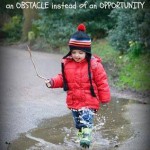 My daughter brought a book home from preschool last week called The Huge Bag of Worries by Virginia Ironside. I read it to my three children at bedtime and was not ready for the conversation that ensued.
My daughter brought a book home from preschool last week called The Huge Bag of Worries by Virginia Ironside. I read it to my three children at bedtime and was not ready for the conversation that ensued.
The book is about a girl called Jenny. Everywhere she goes, she is followed by a big, blue bag of worries. The bag grows as she ‘carries’ it around. She tries to tell her Mum, her Dad, her brother and her best friend about her new blue bag, but she can’t. She even gets her dog, Loftus to try to help. It is not until she cries on the footpath and the lovely old next-door neighbour sees her crying and comes to speak to her that she is able to lether bag of worries open. One by one, Jenny is able to let her worries go. This lovely old lady neighbour listens to her and helps her classify her worries. She is an ear and has time to just ‘be’ with Jenny. The moral to the story is that if you talk to an adult about what is worrying you, you can let your worries go. If you have the right support networks, worries can be heard and acted on. You are not in this alone.
All snuggled up in bed after reading the book, my children led their own discussion about what our worries looked like and how we could let them go. My eldest daughter had the biggest worries – there were the usual things about moving and making friends but other worries came out too. We each named our worries and blew them away together. I walked downstairs that night with a deeper understanding of what my children were dealing with, a somewhat lighter heart knowing we were all in this together and now I was armed with a better way to support my children through their own worries for this week. I am going to try to integrate blowing away our worries into our weekly routine somehow.
Childhood anxiety is a growing concern in Australia with 14 per cent of children aged between 4 and 17 experiencing mental health or behavioural problems. This, coupled with the statistic that 1 in 5 adults will experience a mental illness in their lifetime, now is the time we need to build resilience and support networks for our children.
When I was growing up in a small country town, the community was rife. If I couldn’t talk to my mum about something, I talked to my mum’s friends because we saw them three or four times a week or the school teacher who knew my family and background. We saw lots of people we knew at our house, at their house, at the swimming poor or at the pub on a Friday night. The kids would all run about in the park across the road and adults would talk at the bar. I don’t remember there being any serious drinking (well maybe a little bit), it was just the community place to go to see people and find a sense of belonging. Many of the local problems were sorted out at the pub and families were connected.
For my children, the community has dwindled. I talk to my friends about this concern often. Unless you truly search for it, there is no longer the community spirit or neighbourly love to help kids like Jenny open up and be heard. Many of the school communities have also changed with the local public schools catering for a wider catchment area as well as the rise of independent schools. Safety of children roaming about on their own and meeting others they can talk to in a safe environment is also reduced for our children. If you haven’t found your families community – a place where people can meet – it is time to go outside your bounds and explore. Finding a community where children and adults can connect is important for mental and social wellbeing and the first step to ensuring our children are growing up feeling well supported and not alone.
Where is your community? Are your children (and you!) well supported and connected?







Sometimes anxiety is just in kids. Community and talking absolutely helps your standard variety childhood anxiety, but some kids need more. Often children who suffer from anxiety are the most likely to open up and talk. We enjoyed this book too, but for my son it was confusing because talking doesn’t seem to make his anxieties go away. x
Thanks for the great insight Maxabella! I certainly agree that some kids need more – my daughter gets anxious over moving house and given we are a defence family, it is constant! It is all about what is right for your child and supporting our children with the best resources for their journey.
Sometimes anxiety is just in kids. Community and talking absolutely helps your standard variety childhood anxiety, but some kids need more. Often children who suffer from anxiety are the most likely to open up and talk. We enjoyed this book too, but for my son it was confusing because talking doesn’t seem to make his anxieties go away. x